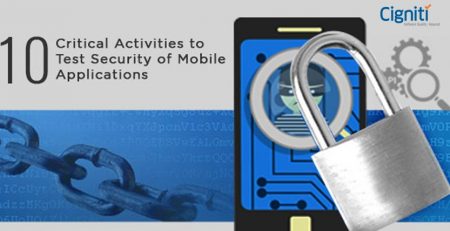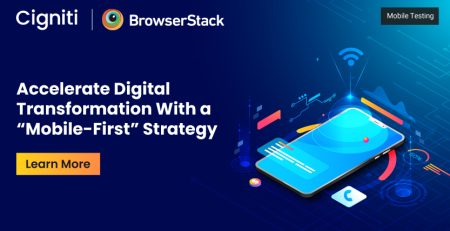4 Top Challenges of Mobile Application Testing & How to Overcome Them
Today, every day, thousands of new apps are uploaded. With apps integration now possible into cars, wearable tech and home appliances, people download them by billions on their smart devices – tablets, smartphones, vehicles, watches, kitchen appliances, etc. – only to move on to download an alternative if the app is not up to their standards or doesn’t fulfil their needs. This increasing intolerance towards below-par performance, device compatibility issues, functional defects, or poor user experience makes mobile testing of apps a business critical function.
The need to launch the perfect app, and then to continuously keep on upgrading it to match the wants of consumers is creating a tremendous, continuous pressure on the professionals responsible for quality and testing – not to forget the developers. The testers need to stay upskilled to be able to manage the ever expanding number of configurations, OSs, devices, OSs, user interfaces, etc., QA departments are trying to catch-up with innovative methodologies like Agile and DevOps, along with testing apps properly before releasing them. Add this to the challenge of insufficient and inefficient mobile testing tools that do not allow testing apps to the maximum levels.
As per the Cap Gemini Quality Report (Mobile Testing), almost 18% companies state lack of time to test mobile apps, 65% say they do not have the right tools, and 52% cite lack of devices as reasons for not performing mobile testing. To overcome some of these challenges of mobile testing, per the World Quality Report 2015-16, 35% of the QA and Testing Budget for new development is being spent on mobile and front office (customer channel) solutions.
4 Mobile Testing Challenges and Solutions
Most organizations are neither ready, nor able to manage the ever growing complicated web of multiple OSs, devices, platforms, or services. Even if they are, they have to face the challenges of:
- Platform, OS and Device Fragmentation: Not just newer and smarter mobile devices, but also operating systems are being launched with such a high frequency that it is becoming very complicated to understand the possible permutations and combinations required to provide the seamless functioning of apps – so desired by the users. Device fragmentation is by far the most complicated aspect of the mobile testing matrix – especially for the Android operating systems. In 2012, there were nearly 4,000 separate Android device models available. In 2013, the number exploded to 12,000. Even the variety of mobile operating systems pose a huge challenge for engineering teams. What complicates this further is the compatibility issues mobile applications face while being deployed across devices having different Operating systems like iOS, Android, Blackberry, Windows etc. or Versions of an operating system such as iOS 4.X, iOS 5.X, BB 4.X, 5.X and 6.X.
The following solutions may be useful in solving the issue:
- Identify the issues using emulators, and test with real devices, and remotely accessed devices. This also helps in identifying security and network impact.
- Identify the targeted audience and the most popular devices in a geography. This will help save a lot of time and also help helps focus on a smaller set of issues.
- Identify and use a mix of internal mobile lab and cloud-based mobile testing services.
- Mobile device’s physical characteristics: There are three approaches to mobile app architecture: native, Web/HTML5 and hybrid apps. Test case scenarios differ for each, especially for stress, performance, conformance and compatibility testing. While Native apps have a reduced testing scope, Web and hybrid apps need both on-/off-platform test cases, thereby leading to back-end issues. While Web-only apps need to be tested more rigorously for the choice of browser versions, Native and hybrid apps must be tested for successful download, execution, platform interaction, and updates.
Because all apps face regular mobile testing challenges, the simplest solution to avoid the additional complexity (that will arise due to multiple app architectures) is to eliminate one or both of the alternatives. - Network Diversity: With just a dozen odd Network carriers ruling the connections world and dozens more trying to fight for their share, fragmentation in this case is far more complicated than in terms of OSs. While using Network emulators helps understand and provide a basic level of testing, but testing on real networks is also necessary.
A lot of organizations try using device emulators along with an operator’s web or test proxy to reduce/avoid airtime charges along with an instrumented test stack. Though Cloud-based network test services may prove to be the best testing scenario, most of them have to shell out remote carrier coverage. While performing testing using a WiFi Network, the following aspects can also be checked:
- How does the app operate offline?
- Is the memory being impacted in unexpected ways? Or are there any constraints?
- What is the impact of different Wi-Fi speeds, low signal strength, 3G, or 4G networks?
- What happens when you switch to Wi-Fi or the network drops or vice versa?
- Security considerations such as encryption, multi-user support, low-level resource usage, and buffering problems or garbage data generation.
- Performance & Security: With so much of personal data being stored and shared across apps and devices, it has become imperative that performance and security testing of apps on a public cloud is given a very serious consideration, and all possible tests conducted to ensure the data privacy.
While a provision of testing early and testing often sounds gratifying, and may also enhance usability, testing the apps on a secure and private cloud may help provide the required access to testing teams which will ensure avoidance of data breaches. The above activities will identify security issues quicker and fixing them before production will not only save from any potential harm, but also help the organization save a lot of costs as a bug fixed before production saves about 20 times cost than that after production.
While Smart phone testing challenges may be many and overwhelming, but there’s nothing that resolves a challenge faster than the correct partner. Cigniti’s state-of-the-art mobile test lab uses the latest and best in mobile testing to bring you better quality and quicker time-to-market. Reach out to us today and we will be happy to help you with right mobile app testing strategy.






Leave a Reply